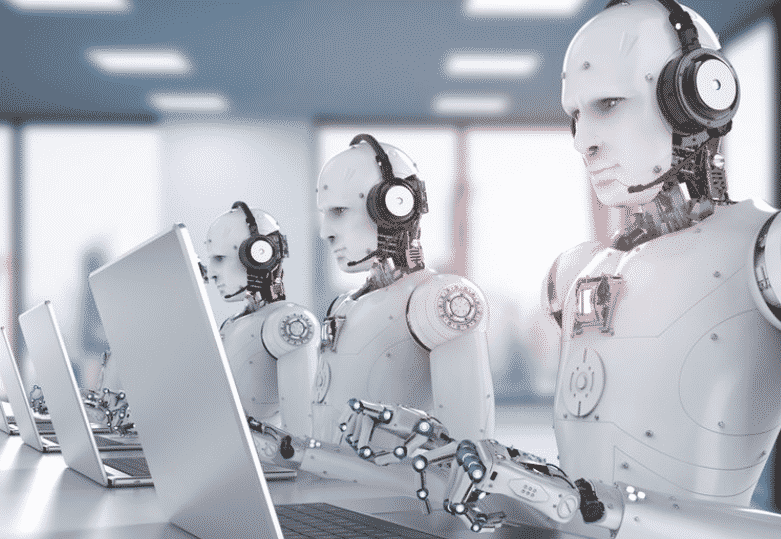The RPA segment, or robotic process automation, was noted by Gartner analysts as the fastest growing category of enterprise software back in 2019. But investors and large corporations are only now really interested in this market.
Why the RPA market is growing now
Last year, it became clear that small and medium-sized businesses urgently need to cut costs, and robots are more reliable in situations where people are massively ill and recover for a long time.
The RPA technologies themselves matured, began to use artificial intelligence, and became more interesting for customers.
The pandemic has highlighted the need and accelerated the development of solutions to automate routine work. According to wikibon.com, in 2007-2017 in the United States and 15 European countries, the rate of annual growth in labor productivity decreased from 1.5-2.5% to 0.5-1.0%, which can partly be explained by ubiquitous computerization and the use of the Internet in the workplace.
RPA technologies have the potential to improve workforce productivity by allowing employees to concentrate on complex tasks, as well as reducing the risk of human error in simple ones.
RPA market in numbers
By the end of 2020, the RPA technology market was still valued at $ 1.5 billion. After the pandemic ends, due to the large technological shift it caused, the market is expected to grow by more than 30% per year and will reach size by 2027. $ 19.5-25.6 billion
Software development and installation costs account for approximately 40-50% of this market; the rest is for integration costs. The first component is the main driver of growth in the industry, its rate is forecasted at the level of 60–70% per year.
Gartner analysts believe the market will grow by a quarter from 2020 to 2022, to nearly $ 600 billion.
It is understood that the introduction of robotization of processes is no longer an alternative, but an economic necessity. But the market is growing not only due to new customers. According to Deloitte, at the beginning of 2020, 42% of companies participating in the study began to implement robotization in some “not modern” countries in one way or another, and 53% in the world.
It is interesting that in some post-Soviet countries only 4% of respondents have automated more than 50 processes; most companies start robotizing their business with one or three processes. At the same time, Deloitte is talking about almost global automation in five years, if the current pace of RPA adoption continues.
Further development of RPA technologies will shift to more complex areas: digital transformation of business processes and automatic decision-making systems.
In 2020, noticeable acquisitions in the RPA market began, which continued that year: Microsoft bought Softomotive, IBM – WDG Automation, ServiceNow – Intellibot. Corporations are rushing to take their place in a potentially multi-billion-dollar market.
Who uses RPA and what for?
Most often, RPA solutions are of interest to financial organizations, telecom and IT, retail and wholesale trade, energy, and mining industry. Last year, the pharmaceutical and healthcare industries ranked fourth among the industries in which RPA was most prevalent.
Olive, for example, used a combination of computer vision and RPA to make it easier to manually enter data when testing customers for coronavirus. And a hospital in Dublin used RPA to process coronavirus tests and get tests faster than manual processing.
Usually, accounting, HR, and IT tasks are robotized. McKinsey’s research shows that at least a third of the processes in 60% of jobs can be automated.
Deloitte says that organizations, having tested RPA technologies on simple processes, become bolder and begin to implement already cognitive technologies that reproduce human functions.
Key market players
Among the developers of RPA products there are both individual companies, such as UiPath, Automation Anywhere, NICE, Blue Prism, AntWorks, Appian, Datamatics, Nintex, Rocketbot, as well as global software giants developing the RPA direction within their own business, for example, Microsoft. IBM and SAP.
In 2021, the success of RPA technologies was recognized by the stock market, when UiPath, the largest player in the sector with a market share of 27%, conducted an IPO on the New York Stock Exchange, raising $ 1.4 billion. Only two other software companies have succeeded in the past seven months. surpass this figure. UiPath has a market cap of $ 29.1 billion. Investors include CapitalG and Sequoia Capital, and its client list includes names such as Amazon, EY, and Bank of America.
Another notable market player, which is now on everyone’s lips, is Automation Anywhere. The company controls 19% of the RPA technology market. In March of this year, it introduced the new Automation 360 software platform for unified business automation using artificial intelligence technologies and announced a strategic partnership with Google Cloud.
While this is a private company, but experts are awaiting its IPO – Automation Anywhere looks stronger than other competitors. After the success of UiPath, the market has become bolder in its expectations, investors are looking for an opportunity to enter the equity capital of Automation Anywhere during the early stages of growth.
This has already been done by Salesforce Ventures, Goldman Sachs, and Softbank Vision Fund. The company was valued at $ 6.9 billion in the last round in 2019.
The top three also include the public British company Blue Prism with an estimate of $ 2.2 billion. It is the oldest player on the market, founded back in 2001. A mature product allows the company to steadily maintain its market share at the level of 8-10%, but the share price, on the contrary, is characterized by volatility.

